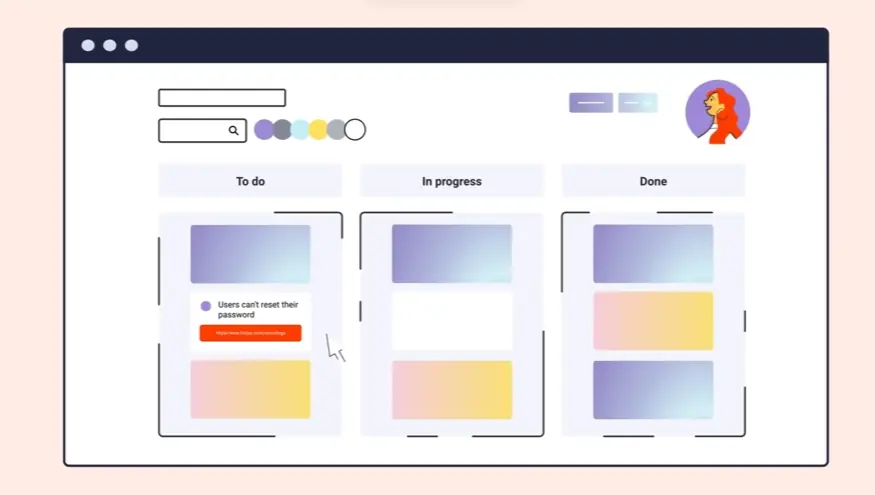
How can an enterprise application demo video showcase complex features clearly?
Showcase complex features through clear visuals, concise explanations, and step-by-step demonstrations within the application's interface.
What narrative strategies best engage enterprise decision-makers?
Engage enterprise decision-makers with narratives focused on ROI, efficiency gains, and problem-solving capabilities. For example, demonstrate how the software automates tasks, reduces costs, or improves decision-making.
What's the ideal length for an in-depth enterprise software walkthrough?
Ideal length varies based on complexity, ranging from 60-second overviews to 3-5 minute deep dives. Tailor length to content and audience.
How can a demo video highlight the scalability of an enterprise solution?
Highlight scalability by showcasing the software's ability to handle increasing data volume, user numbers, and integration needs. Visualize growth scenarios.
What pre-production steps ensure an effective enterprise software demo?
Effective pre-production includes:
Client briefings and needs analysis
Script development and storyboarding
Technical planning and resource allocation
How do I tailor a demo video to specific enterprise client needs?
Tailor demos by incorporating client-specific branding, data, use cases, and pain points. Address individual needs and challenges.
How can interactive elements enhance an enterprise application demo?
Enhance demos with interactive elements like clickable buttons, data input fields, and branching scenarios, enabling user exploration.
What are common pitfalls to avoid in enterprise software demo videos?
Avoid jargon, overly technical details, and lengthy explanations. Focus on user benefits and clear value propositions.
How can existing case studies be integrated into a demo video?
Integrate case studies with quantifiable results and client testimonials to build credibility and demonstrate real-world impact.
What UI/UX best practices apply to enterprise software demo videos?
Apply UI/UX best practices, including intuitive navigation, clear visuals, and consistent branding, to enhance user experience.
How can a demo video simplify complex enterprise workflows visually?
Simplify complex workflows visually using animations, diagrams, and step-by-step demonstrations. Break down processes into digestible steps.
How can a demo video effectively position enterprise software in the market?
Effectively position enterprise software by emphasizing key differentiators, targeting specific pain points, and showcasing unique value propositions.
How does a demo video drive enterprise lead generation and conversions?
Drive lead generation and conversions with compelling calls to action, clear contact information, and targeted distribution strategies.
How can a demo video improve enterprise software trial adoption rates?
Improve trial adoption rates by showcasing ease of use, key benefits, and successful implementation examples. Reduce barriers to entry.
How can a demo video build trust and credibility with enterprise clients?
Build trust and credibility by presenting clear value propositions, demonstrating expertise, showcasing client testimonials, and maintaining transparent communication. Fixed-fee pricing from $1000-$6000 for a 60-second video, depending on complexity, with multiple revisions included. Typical turnaround time is 3-8 weeks.
How to plan and optimize Enterprise Application Walkthrough Demo Videos?
Emotional Resonance: "People buy with emotion and justify with logic." - Nathalie Nahai. Advids applied this principle for a healthcare client. We crafted an emotionally resonant enterprise application walkthrough demo video showcasing the positive impact of their platform on patient lives, leading to a 15% boost in lead generation.
Actionable: Connect with audience emotions to drive engagement and action.
Content Clarity: "Content isn't king, it's the kingdom." - Lee Odden. Advids leveraged this wisdom for a manufacturing client. We developed a concise and informative enterprise application walkthrough demo video highlighting key features and benefits, resulting in a 10% rise in sales inquiries.
Actionable: Deliver clear, concise content that educates and persuades viewers.
Brand Differentiation: "If you don't have a competitive advantage, don't compete." - Al Ries. Advids implemented this strategy for a retail client. We created a unique and memorable enterprise application walkthrough demo video showcasing their brand's personality and value proposition, leading to a 5% increase in brand awareness.
Actionable: Highlight unique selling propositions to stand out from competitors.
Product Value Communication: "Marketing is not about selling. Marketing is about creating value for your customers." - Harvey Lee. Advids applied this principle for a logistics client. We developed an enterprise application walkthrough demo video that clearly demonstrated the value proposition of their software, resulting in a 25% increase in conversions.
Actionable: Clearly communicate product value to drive customer conversions.
Targeted Messaging: "The aim of marketing is to know and understand the customer so well the product or service fits him and sells itself." - Yasmeen Turayhi. Advids used this approach for an education technology client. We created a targeted enterprise application walkthrough demo video addressing the specific needs of educators, resulting in a 30% increase in demo requests.
Actionable: Tailor messaging to specific audience segments for maximum impact.
Why Advids for Enterprise Application Walkthrough Demo Video?
At Advids, we create high-quality, original Enterprise Application Walkthrough Demo Videos designed to achieve your specific business objectives. Our unique blend of creative storytelling, cutting-edge technology, and proven experience ensures your vision translates into a compelling and effective demonstration.
Unlocking the Power of Demo Videos:
Customized Enterprise Application Walkthrough Demo Video Solutions: We tailor each project, whether it's a concise explainer video or a detailed character animation, to perfectly match your brand, style, and target audience.
Creative Storytelling Through Animation: Our team of animators and storytellers craft engaging narratives that captivate viewers and clearly demonstrate the value of your application.
Cutting-Edge Enterprise Application Walkthrough Demo Video Technology: We utilize the latest software and techniques to create visually stunning videos that leave a lasting impression and drive user adoption.
Experience and Trust:
12+ Years of Proven Success: With over 3400 clients served, we have a deep understanding of what makes a successful Enterprise Application Walkthrough Demo Video. We've completed over 320 successful Enterprise Application Walkthrough Demo Video projects.
Trusted by Industry Leaders: From startups to Fortune 500 companies, brands like Razorpay, Ola, Mercedes, the United Nations, Continental, and Mercer rely on our expertise.
Client Satisfaction Guaranteed: Our commitment to excellence is reflected in over 109 five-star Google reviews, showcasing our talent, creativity, and dedication to client satisfaction.
A Collaborative Approach:
Collaborative Process: We work closely with you from concept to completion, ensuring your vision is realized in the final animation. Your input is crucial throughout the entire process.
Strategic Communication: Open and clear communication is fundamental to our approach. We prioritize understanding your needs, target audience, and brand identity to create truly impactful Enterprise Application Walkthrough Demo Videos.
Ready to unlock the potential of Enterprise Application Walkthrough Demo Video for your business with the latest video design trends of 2024? Let Advids be your trusted partner in transforming your ideas into engaging and effective animated experiences.
Checkout some of the projects and work our team at Advids has been producing:
What is an Enterprise Application Walkthrough Demo Video?
An enterprise application walkthrough demo video eo that provides a Visual and Interactive Demonstration of an enterprise application's features, functionalities, and benefits. It typically involves screen recordings, voiceovers, and animations to guide viewers through the application's interface and showcase its capabilities. These videos are designed to Educate Potential Customers , onboard new users, and drive adoption by showcasing the application's value proposition r and engaging manner.
Enterprise application walkthrough demo videos commonly used for various purposes, including Sales Presentations , product demonstrations, customer training, and support documentation. They can be used to showcase specific features, Highlight Use Cases , and address common customer questions. By providing a Visual and Interactive Experience , these videos can effectively communicate the value of an enterprise application and Encourage Viewers to Take Action , such as requesting a demo or signing up for a free trial.
What do top Enterprise Application Walkthrough Demo Videos have in common?
Mastering enterprise application walkthrough videos requires focusing on the user journey and showcasing Tangible Value .
Ideal Customer Profile - Tailor messaging to resonate with specific user needs and pain points. Focus on their challenges and how the app solves them.
- Compelling Script - Use concise, Benefit-Driven Language , focusing on the "why" behind each feature. Prioritize clarity and conciseness.
- Narrative Arc - Structure the demo around a clear beginning, middle, and end, creating a Memorable Experience . Emphasize emotional connection.
- Intuitive User Journey - Guide viewers smoothly through the app's functionality, highlighting ease of use. Use visual cues to enhance understanding.
- Highlight Key Features - Prioritize features that deliver the most value to the target audience. Show, don't just tell.
- Problem/Solution Approach - Clearly define the problem, then demonstrate how the app solves it effectively. Use visual aids to illustrate the solution.
- Realistic Use Cases - Showcase the app in authentic scenarios that resonate with the target audience. Use real-world examples.
- Performance Metrics - Use charts and graphs to visually represent key performance indicators. Quantify the value proposition.
- Client Testimonials - Feature short, impactful quotes from satisfied clients. Focus on quantifiable results.
- Competitive Differentiation - Clearly articulate what sets the app apart from competitors. Highlight unique features and benefits.
What makes an Enterprise Application Walkthrough Demo Video effective?
Effective enterprise application walkthrough demo videos are meticulously designed to capture the viewer's attention, clearly communicate the application's value proposition, and drive desired actions. These videos are typically characterized by a compelling narrative that resonates with the target audience, high-quality visuals that showcase the application's features and benefits, and a clear Call to Action that encourages viewers to take the next step.
Strategic enterprise application walkthrough demo videos employ various techniques to maximize their impact. These include incorporating storytelling ke the content more relatable, using Clear and Concise Language to avoid overwhelming viewers with technical jargon, and showcasing Real-World Use Cases to demonstrate the application's practical value. Effective demo videos aim to educate, engage, and inspire viewers, ultimately leading to increased user adoption, Improved Customer Satisfaction , and enhanced brand awareness.
How long should your Enterprise Application Walkthrough Demo Video be?
Optimize enterprise application demo video length for maximum impact by aligning video type, content, and target audience stage.
Pre-production Considerations for Determining Video Length:
- What core features need showcasing?
- Who is the intended viewer?
- What is the video's objective?
- Which workflow is prioritized?
- What style best suits the message?
- What platform dictates length?
- Does the video need animation?
enterprise application walkthrough demo video length guide
| Enterprise Application Walkthrough Demo Types | Video Length | Use Case | Funnel |
|---|
| Screen Recording | 45-60 seconds | Concisely showcases core features, ideal for quick overviews, uses clear on-screen annotations | Awareness/Consideration |
| Live Demo | 1-2 minutes | Demonstrates application in real-time, highlighting key workflows, engaging presenter | Consideration/Decision |
| Product Tour | 1-2 minutes | Guided exploration of key features, visually appealing, uses smooth transitions and upbeat music | Consideration/Decision |
| Tutorial Video | 1-2 minutes | Step-by-step instructions, clear visuals, caters to users needing detailed guidance | Decision/Action |
| Explainer Video | 30-60 seconds | Explains the application's value proposition, uses animation to simplify complex concepts | Awareness/Consideration |
How to create Enterprise Application Walkthrough Demo Videos?
Craft compelling enterprise application walkthrough videos that drive user adoption and achieve measurable business results. Mastering the pre-production and production phases is key to creating impactful demos.
* Define Objectives - Focus on measurable goals like conversion rates or trial sign-ups to track success.- Target Audience - Understanding their technical proficiency shapes the video's complexity and language.
- Script & Storyboard - A well-structured script and storyboard ensure a clear and concise message.
- Video Style Selection - A Consistent Style reinforces brand identity and enhances viewer trust.
- Asset Gathering - High-quality assets create a professional and polished final product.
- Structure Planning - A logical flow keeps viewers engaged and prevents information overload.
- Screen Recording - High-resolution recordings ensure clarity and prevent pixelation.
- Animation & Graphics - Animations clarify complex processes and improve viewer comprehension.
- Voiceover Recording - A clear and concise voiceover guides viewers and enhances understanding.
- Video Editing - Smooth transitions and pacing maintain viewer engagement.
- Call to Action - A compelling call to action drives viewers to take the desired next step.
- Platform Optimization - Ensures the video is viewable across all devices and platforms.
How to Target Your Demo Video to the Right Audience
Creating compelling demos is just the first step. To truly maximize impact , we need to ensure our videos reach the right people. Let's explore how to target your demo video to the right audience and boost those conversions .
Think about it – a demo designed for a seasoned developer will look vastly different from one aimed at a first-time user . understanding your audience is paramount. It's about speaking their language , addressing their specific needs , and showing them how your application solves their unique challenges. For instance, top application walkthrough videos often tailor their content to different user personas, showcasing relevant use cases and highlighting specific benefits.
Here's how we can laser-focus our demo videos:
- Understand Your Audience: Dive deep into their demographics , pain points , and motivations. Are they tech-savvy or beginners ? What are their daily struggles? What are their goals? This knowledge will shape your messaging and visuals.
- Tailor Your Message : speak directly to their needs. Showcase how your application solves their specific problems. For example, if you're targeting sales teams, highlight features that streamline lead generation and improve closing rates . Remember, business application explainer videos can be incredibly effective for simplifying complex concepts and showcasing value to a broader audience .
- Show, Don't Just Tell: Use real-world scenarios and Compelling Visuals to demonstrate your application 's value. Instead of simply listing features, show them in action . software demo video examples can provide valuable inspiration for crafting engaging narratives.
- Optimize for Platform and Length: Consider where your audience consumes content and adjust your video length accordingly. A short, snappy demo might work well on social media, while a more in-depth tutorial might be better suited for your website.
By focusing on these key strategies, we can create targeted demo videos that resonate with our audience, drive engagement, and ultimately, achieve our business objectives.
Crafting a Compelling Script for Your Software Demo
Crafting a compelling script is where the magic happens. It's our chance to transform features into benefits and turn viewers into users. Let's dive into how we can make our software demo scripts truly shine. A great script isn't just about listing features; it's about telling a story. It's about showing our audience how our software can solve their problems and make their lives easier. Think of it as a conversation, not a lecture.
Let's explore some key ingredients for a captivating script:
- Know Your Audience: Are we talking to tech-savvy developers or first-time users? Tailor our language and complexity accordingly. For instance, if we're targeting sales teams, let's highlight features that streamline lead generation .
- Focus on Benefits: Instead of simply listing features, let's paint a picture of how those features translate into tangible benefits. Show, don't just tell. Professional software demo video examples often excel at this.
- Structure Your Narrative: Every good story has a beginning, middle, and end. Let's structure our demo in a way that keeps viewers engaged and guides them through the key functionalities. Need inspiration? Check out application walkthrough video examples to see how others effectively structure their demos.
- Include a Call to Action: What do we want viewers to do after watching our demo? Let's make it crystal clear with a compelling call to action. Whether it's requesting a demo, signing up for a free trial, or downloading a resource, let's guide them towards the next step. When showcasing specific features, consider creating targeted Enterprise App Feature Videos that focus on specific use cases.
By focusing on these key elements, we can create software demo scripts that not only inform but also inspire. A compelling script is the foundation of a successful demo, setting the stage for increased user adoption and measurable business results.
The Importance of a Strong Narrative in Enterprise Demo Videos
Let's move beyond feature lists and explore the magic of storytelling. A compelling narrative transforms a dry product demo into an engaging experience. It's the difference between showing what your application does and making viewers *feel* its value. Think about it – even software product demo videos, often perceived as technical, benefit greatly from a well-defined narrative.
We've covered the technical aspects, but now let's dive into the heart of engagement: the narrative. A strong narrative is the secret sauce that captivates your audience and drives them to action. Let's explore how some of the best enterprise application demo videos leverage narrative to their advantage.
- A compelling story makes your demo memorable. Think of it as a mini-movie showcasing your application as the hero.
- Narratives forge emotional connections. When viewers connect with your story, they're more likely to connect with your product.
- A clear beginning, middle, and end keeps viewers hooked. Just like a good movie, your demo needs a clear narrative arc.
- Focus on the "why." Show viewers how your application solves their problems and makes their lives easier.
By crafting a compelling narrative, we transform our enterprise application demo videos from mere product overviews into persuasive tools that resonate with our audience and drive results. Analyzing best enterprise application demo videos reveals a common thread: a strong, compelling narrative.
Optimizing Your Demo Video for Different Platforms
Let's talk about tailoring our awesome demo videos for different platforms. Think about it – a snappy demo that shines on LinkedIn might not have the same impact on TikTok. Understanding each platform's unique vibe is key to maximizing engagement. Just like we tailor our outfits to different occasions, we need to adapt our videos to different digital landscapes. For instance, corporate software demo examples might benefit from a more professional tone on LinkedIn, while saas demo video examples could be more playful on Instagram .
Creating high-quality software demo videos is just the beginning. We need to ensure they reach the right audience on the right platform. Let's explore how to optimize our videos for maximum impact.
By following these tips, we can ensure our demo videos shine on every platform, reaching a wider audience and driving those conversions .
Creating a Call to Action that Converts in Demo Videos
We've mastered the art of creating engaging demo videos. Now, let's unlock the secret to turning viewers into customers: the call to action. A compelling CTA isn't just a button; it's the bridge between interest and action. Think of it as the final scene in a movie, guiding the audience towards the desired resolution. Just like in compelling explainer video examples for software, a clear CTA is essential.
Let's explore how we can craft CTAs that convert:
- Clarity: Imagine watching a movie with a confusing ending. Frustrating, right? A clear CTA eliminates confusion, telling viewers exactly what to do. "Get Your Free Trial Today" is far more effective than a vague "Learn More."
- Urgency: Limited-time offers create a sense of urgency, encouraging viewers to act now. Think of a flash sale – the ticking clock motivates immediate action.
- Value Proposition: highlight the benefits of clicking that button. What problem does your software solve? What value does it offer? Just like in B2B software presentation videos, a strong value proposition is key.
- Relevance: A CTA should always align with the video's content and target audience. A demo targeting sales teams should focus on lead generation, not technical specifications. Even animated software demo video examples benefit from a relevant CTA.
A compelling call to action is the final piece of the puzzle. By following these strategies, we can transform viewers into loyal customers, driving measurable business results.
Author & Editor Bio
A video producer with a passion for creating compelling video narratives, Jai Ghosh brings a wealth of experience to his role. His background in Digital Journalism and over 11 years of freelance media consulting inform his approach to video production. For the past 7 years, he has been a vital part of the Advids team, honing his expertise in video content planning, creation, and strategy.
His collaborative approach ensures that he works closely with clients, from startups to enterprises, to understand their communication goals and deliver impactful video solutions. He thrives on transforming ideas into engaging videos, whether it's a product demo, an educational explainer, or a brand story.
An avid reader of modern marketing literature, he keeps his knowledge current. Among his favorite reads from 2024 are "Balls Out Marketing" by Peter Roesler, "Give to Grow" by Mo Bunnell and "For the Culture" by Marcus Collins. His results-driven approach ensures that video content resonates with audiences and helps businesses flourish.




